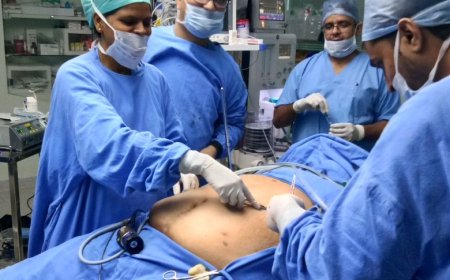How Secure Are Teleradiology Services? Data Protection Explained
This blog dives into how teleradiologists and teleradiology specialists maintain the confidentiality, integrity, and security of patient data. It also explains the standards, technologies, and practices that form the foundation of a secure teleradiology system.

As the demand for rapid and accurate medical diagnostics continues to grow, teleradiology services have emerged as a reliable solution for hospitals, clinics, and imaging centers around the world. By enabling remote interpretation of radiological images, these services help ensure timely diagnoses even in underserved areas. However, with the increasing exchange of sensitive patient data across digital platforms, one critical question often arises: How secure are teleradiology services?
This blog dives into how teleradiologists and teleradiology specialists maintain the confidentiality, integrity, and security of patient data. It also explains the standards, technologies, and practices that form the foundation of a secure teleradiology system.
Understanding Teleradiology and Its Data Challenges
Teleradiology involves transmitting radiological patient images like X-rays, CT scans, and MRIs from one location to another for interpretation by a qualified radiologist. While this enables fast reporting, especially in emergency or off-hour situations, it also means large volumes of patient data travel across networkscreating potential vulnerabilities if not handled correctly.
Healthcare data is among the most sensitive types of personal information. A breach could expose a patients entire medical history, leading to not only privacy violations but also identity theft and financial fraud. Thats why teleradiology specialists must implement stringent data protection protocols to uphold patient trust and comply with international health data standards.
Regulatory Compliance: The First Layer of Security
For teleradiology services to be trustworthy, they must comply with regional and international data protection regulations:
-
HIPAA (Health Insurance Portability and Accountability Act) In the United States, HIPAA outlines the standards for safeguarding medical data. It mandates encryption, audit trails, and secure access controls.
-
GDPR (General Data Protection Regulation) Applicable in Europe, GDPR enforces strong data privacy rights, including the right to access, correct, and delete personal information.
-
NABH and DICOM Standards In India, standards like NABH accreditation and the DICOM (Digital Imaging and Communications in Medicine) protocol help ensure secure imaging and interoperability among healthcare providers.
Compliant teleradiology providers must undergo periodic audits and maintain transparency in their data handling practices. This ensures that both patients and referring physicians can trust the security of the service.
Data Encryption: Shielding Information in Transit and Storage
Encryption is the cornerstone of data protection in teleradiology services. It ensures that even if someone intercepts the data during transmission, it remains unreadable without a decryption key.
-
End-to-End Encryption (E2EE) All image files, reports, and communications between referring clinicians and teleradiologists are encrypted during transmission and decryption happens only at the authorized endpoints.
-
At-Rest Encryption Stored data, including archived reports and images, is also encrypted using protocols like AES-256. This adds an extra layer of security against data theft from internal or external actors.
By applying encryption both in transit and at rest, teleradiology platforms effectively reduce the risk of data breaches.
Secure Access Controls and Authentication
Another vital aspect of data protection is controlling who has access to the system and how they access it.
-
Role-Based Access Control (RBAC) Only authorized users (e.g., referring doctors, teleradiology specialists, IT administrators) are granted access to specific areas of the system. For instance, a technician uploading scans cannot view the final diagnostic report.
-
Multi-Factor Authentication (MFA) MFA adds a layer of verification (such as SMS codes or biometric scans) to prevent unauthorized login attempts, even if a password is compromised.
-
Audit Trails Every login, upload, download, and report access is logged. This helps detect suspicious activities and enhances accountability.
Strong authentication and access controls ensure that only vetted users can view or manipulate patient data.
Secure Communication Channels
All communicationswhether between teleradiologists and referring physicians or internal support teamsshould be conducted via secure, encrypted channels.
-
HL7 Messaging Protocols These standardized communication protocols ensure interoperability and secure data exchange across healthcare systems.
-
Encrypted Messaging Apps and Email Gateways Many teleradiology providers integrate secure messaging apps into their platforms to allow seamless yet protected communication among stakeholders.
Avoiding traditional, unsecured communication tools like regular email or SMS is crucial to preventing data leaks.
Cloud Security in Teleradiology
Most modern teleradiology services use cloud platforms for data storage, sharing, and backup. While cloud solutions offer scalability and convenience, they also demand rigorous security management.
Cloud providers used by teleradiology specialists must:
-
Comply with HIPAA, GDPR, and ISO 27001 standards.
-
Offer server redundancy and disaster recovery.
-
Use data encryption and physical security measures.
-
Provide real-time threat monitoring and breach detection.
Choosing a secure, health-data-compliant cloud service is essential for maintaining continuous protection.
Employee Training and Internal Protocols
Technology alone cannot ensure security. Human error remains one of the leading causes of data breaches in healthcare. Thats why ongoing cybersecurity training for all staffincluding teleradiologists, technicians, and administrative personnelis a must.
Internal protocols should include:
-
Strict password management policies.
-
Immediate reporting of suspicious activities.
-
Routine software updates and patching.
-
Regular security audits and simulated attack drills.
Well-trained personnel are the first line of defense against phishing, malware, and insider threats.
How Anyology Ensures Data Protection in Teleradiology
At Anyology, we understand that trust is the foundation of every healthcare interaction. Thats why our teleradiology services are designed with a security-first approach.
Heres how we protect your data:
-
We work exclusively with certified teleradiology specialists who use encrypted, HIPAA-compliant platforms.
-
Our systems use multi-layered access controls, real-time logging, and end-to-end encryption.
-
Data storage and backups are managed via secure cloud providers with ISO 27001 certification.
-
Every stakeholder undergoes cybersecurity training and adheres to strict confidentiality policies.
Whether youre a small clinic or a large hospital, our secure systems ensure your patients data is always protected.
Final Thoughts: Balancing Innovation with Privacy
Teleradiology has transformed how radiology is practicedenabling faster, more efficient diagnoses, especially in underserved areas. But this innovation must go hand-in-hand with responsibility. Patients and providers must be confident that their data is secure.
By choosing a provider like Anyology, who prioritizes both technological excellence and data protection, you can harness the full potential of teleradiology without compromising on privacy.
If you're looking for reliable, secure, and expert-led teleradiology solutions, connect with us today.


























































